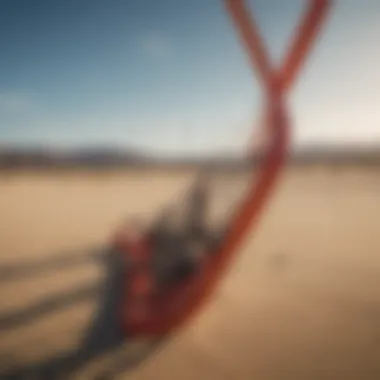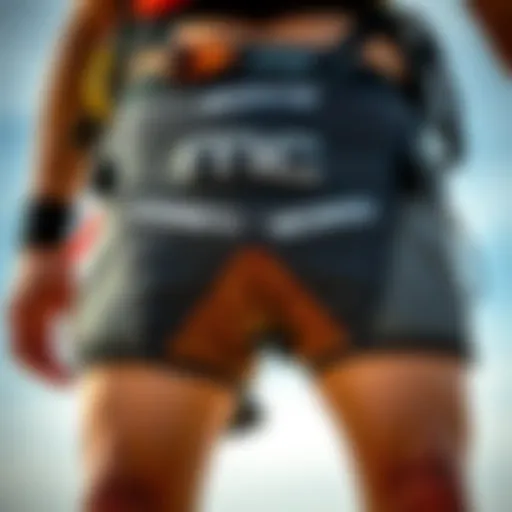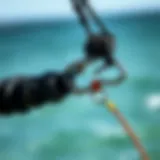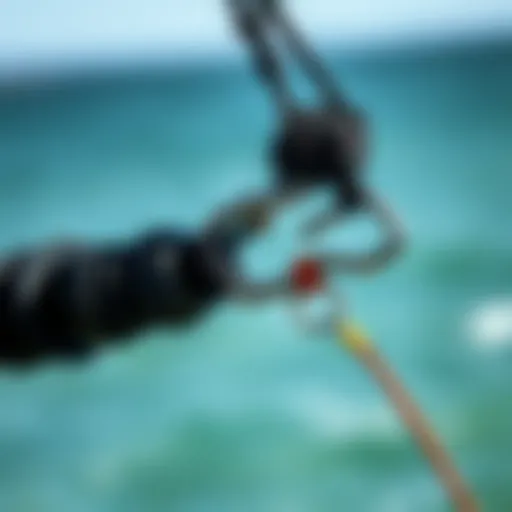Understanding the Kite Bar: Essential Insights


Intro
Kiteboarding, with its blend of adrenaline and grace, is much more nuanced than a casual observer might reckon. At the heart of this sport lies the kite bar, an essential piece of equipment that not only connects the rider to the kite but also plays a vital role in maneuverability and safety. Understanding the kite bar means not only knowing its design or features but also grasping how it fundamentally affects the overall kiteboarding experience. From controlling the kite’s power to ensuring safe landings, the kite bar is a game changer in the lively world of kiteboarding.
This article delves into the intricate details surrounding the kite bar, covering everything from gear insights and maintenance to essential techniques and tips. Each section aims to enlighten both novice enthusiasts and seasoned pros, unfolding the profound impact a well-crafted kite bar can have on the water.
Gear Insights
When considering the kite bar, it's essential to recognize the vast array of options available. Each model caters to specific needs and skill levels, offering various designs and features that can significantly influence performance.
Latest Gear Reviews
Staying abreast of the latest gear can be tricky. However, some standout products currently leading the charge in kite bar technology include the North Trust Bar and the Duotone Fireball. Both have carved out a niche thanks to their innovative designs and functionality.
- North Trust Bar: Known for its simple setup and reliable safety features.
- Duotone Fireball: This bar introduces a unique connection system, allowing for an agile and dynamic connection between the rider and the kite.
These options symbolize just a fraction of what's out there, but they emphasize the importance of selecting gear that aligns with your riding style and preferences.
Essential Gear for Beginners
For those just dipping their toes into kiteboarding, choosing the right gear can be a daunting task. Here are some fundamental pieces a beginner should consider:
- Kite: A well-sized, stable kite that suits your wind conditions, like the Cabrinha Switchblade.
- Harness: A comfortable harness, such as the Mystic Dominator, should provide support and allow for freedom of movement.
- Kite Bar: Opt for a bar that includes easy-to-use features like quick releases, which are critical for safety in unforeseen situations.
This initial setup can make a world of difference in building confidence and skill in those early days on the water.
Techniques and Tips
Once equipped with the right gear, developing your technique is the logical next step. Kiteboarding isn’t just about instinct; it requires a sound understanding of how to manipulate the kite bar effectively.
Advanced Tricks and Techniques
As you develop your skills, the kite bar becomes essential for executing advanced maneuvers. Tricks like the backroll or the kite loop demand precise control and confidence in managing the bar.
"Mastering your kite bar puts the power entirely in your hands, allowing you to express yourself on the water while maintaining a firm grip on safety."
Safety Practices for Kiteboarders
Never underestimate the importance of safety. Kiteboarding can be a thrilling yet risky endeavor if safety practices are overlooked. Always remember to:
- Check your equipment thoroughly before each session.
- Practice your safety releases to ensure you can react swiftly.
- Be aware of your surroundings and potential hazards, whether it's the waves or other kiteboarders.
Taking heed of these tips can prevent mishaps and ensure that your time on the water is enjoyable and safe.
Understanding the kite bar is more than just a technical inquiry; it's about embracing the full kiteboarding experience with knowledge and readiness. As we move through the upcoming sections, the intricacies of design, material, maintenance, and rider control will further illuminate this vital link between kite and rider.
Foreword to the Kite Bar
The kite bar is a pivotal component in the sport of kiteboarding. Understanding its significance expands beyond mere functionality; it serves as the lifeline between the rider and the kite. Kiteboarding enthusiasts—whether they're seasoned pros or curious newcomers—can reap numerous benefits by grasping the intricacies of the kite bar. This section lays down the foundation for what follows, detailing essential elements that underscore the kite bar’s design, purpose, and historical development, all of which will be examined in this article.
Definition and Purpose
At its core, the kite bar is a control mechanism that connects a rider to their kite through a system of lines and pulleys. This device allows for precise maneuverability, enabling riders to steer and depower the kite according to the wind conditions. Unlike other components in kiteboarding, such as the kite itself or the harness, the kite bar serves a dual purpose. First, it directs the kite’s movements, allowing for thrilling zigzags across the water, jumps into the air, and swift turns. Second, it provides safety measures to help prevent accidents and ensure that riders can quickly release themselves from potential hazards.
In more detail, the kite bar typically consists of three main parts: the bar itself, the control lines leading to the kite, and the safety leash that connects to the rider. Each of these elements plays a vital role in the overall functionality, helping to create a seamless experience on the water.
Historical Context
The development of the kite bar has a fascinating history reflecting the evolution of kiteboarding itself. Kiteboarding was born in the late 20th century as adventurous souls experimented with combining elements of surfing and wind sports. Early versions of kite bars were quite rudimentary, often resembling makeshift contraptions, hardly understood in terms of safety or performance.
Over the years, collaboration between athletes, engineers, and manufacturers led to a revolution in kite bar design. Innovations such as the introduction of safety leashes, user-friendly grips, and adjustments for various wind conditions transformed how riders interact with their kites.
With more sophisticated kite bar designs populating the market today, riders now benefit from technology that prioritizes not only performance but also safety. Such advancements reflect a deeper understanding of the dynamics involved in kiteboarding, pushing the sport toward new heights and making it more accessible to a broader audience.
In summary, the kite bar embodies the evolution and innovation within kiteboarding, bridging historical practices with contemporary designs to enrich the athletic journey for all enthusiasts. By grasping its purpose and historical significance, readers will be better equipped to appreciate the complexities and advancements that follow in this article.
Design Components of the Kite Bar
The design components of the kite bar play a vital role in the overall kiteboarding experience. A well-crafted kite bar not only improves control and responsiveness but also enhances safety, making it essential for any rider. Each part serves a specific function and contributes to the bar's performance in various environmental conditions. When choosing a kite bar, understanding these components will help rider make informed choices that can significantly affect their sessions.
Main Parts and Their Functions
Bar Shape and Size
Bar shape and size is crucial in defining how a kite behaves in the air. A wider bar can provide more lateral control, allowing kiters to make swift adjustments while maintaining stability. The diameter and length can also affect feel and comfort. A thicker bar, for example, can be beneficial for those who prefer more grip, whereas a slimmer bar might be favored by those who want less weight.
Key characteristic: The ergonomic design in bar shape offers comfort during extended use. Many riders lean towards a moderate size that balances responsiveness and comfort.
Unique feature: Some kite bars offer customizable widths to suit diverse riding styles, which is an appealing aspect for adventure seekers looking for tailor-made solutions. However, riders must note that adjusting the size may require an acclimation period.
Control Lines
Control lines are the pathway through which a rider communicates with the kite, so their role cannot be overstated. They translate movements into kite reactions, allowing for precise steering and adjustments. The quality of these lines can significantly influence performance. High-tenacity materials are commonly used for durability, but if they've lost tension or show signs of wear, performance can degrade quickly.
Key characteristic: Control lines have varying thicknesses and materials, contributing to their overall strength and responsiveness. Riders often find themselves opting for lines that offer a good balance between elasticity and durability.


Unique feature: Some kite bars are equipped with color-coded lines that simplify rigging and enhance overall safety when setting up. However, if lines are not maintained, they might cause unexpected kite behavior, which could be dangerous.
Safety Leash
The safety leash is a crucial component that serves as a last line of defense during unexpected situations. It connects the rider to the kite, ensuring that if they release the control bar, the kite does not drift away uncontrollably. It's designed to allow a quick release in emergencies while minimizing potential hazards.
Key characteristic: A well-designed safety leash offers both strength and ease of use. Most modern leashes allow for quick detachment while providing the necessary security during regular rides.
Unique feature: Some safety leashes come equipped with a built-in quick release system, further enhancing the speed at which the rider can disconnect from the kite if need arises. However, a downside could be that if the leash gets tangled, it poses a safety risk, highlighting the need for ongoing checks.
Ergonomics and Comfort
Proper ergonomics and comfort greatly enhance the kiteboarding experience, especially during longer rides. A kite bar that feels right in your hands can lead to better performance and enjoyment on the water.
Grip Design
Grip design is more than just about appearance; it directly affects handling and the rider's ability to control the kite comfortably. A well-designed grip offers texture and contours that fit snugly in the palm of the hand, reducing fatigue. The material used can also dampen vibrations, contributing to more responsive control.
Key characteristic: Many grips are designed to accommodate various conditions, whether it's warm and sunny or cold and wet. This versatility enhances overall experience.
Unique feature: Textured grips that absorb moisture can reduce slippage, though they may require thorough cleaning after use, which can add to maintenance efforts.
Weight Distribution
Weight distribution around the bar can impact how the rider feels during maneuvers. A well-balanced bar prevents unnecessary strain on the body, allowing for longer sessions without discomfort. Heftier bars may inspire confidence in control, but they can also impact responsiveness.
Key characteristic: The best kite bars often feature optimized weight distribution to enhance maneuverability without sacrificing stability. Riders are usually keen on bars that are lightweight but sturdy enough for the job.
Unique feature: Some kite bars employ adjustable weights, allowing experienced users to customize their setup according to preference. However, switching weights may require fiddling, which can be off-putting for those valuing simplicity.
"A kite bar is not just a tool; it’s an extension of your body while riding. Get it right, and every session can feel effortless.”
Understanding these components equips kiteboarders with the knowledge to select the right gear for their adventurous endeavors. It's clear that both design and comfort contribute to an overall experience that not only emphasizes safety but also personal preference and performance.
Materials Used in Kite Bars
When it comes to kiteboarding, the kite bar is more than just a tool; it's the bridge between the rider and the kite. The materials used in kite bars can greatly influence performance, safety, and even the longevity of the equipment. There are multifaceted considerations regarding material choices, as each type comes with its own set of advantages and disadvantages. Understanding these materials helps kiteboarders make informed decisions when selecting or maintaining their gear, ensuring that they optimize their kiteboarding experience.
Common Materials
Aluminum vs. Composite
The ongoing debate between aluminum and composite materials for kite bars often boils down to weight and strength. Aluminum is a staple due to its robustness and relatively lightweight nature. A significant advantage aluminum offers is its resistance to corrosion, making it a reliable choice for salty ocean environments. On the flip side, composite materials like carbon fiber are often treasured for their superior stiffness and reduced weight, allowing for increased responsiveness in maneuvering the kite. However, they can be more brittle, cracking under excessive force.
- Aluminum
- Composite Materials
- Characteristics: Strong and lightweight.
- Benefits: Great corrosion resistance.
- Unique Feature: Affordable and widely available.
- Disadvantages: May weigh a bit more than composites in high-end applications.
- Characteristics: High strength-to-weight ratio.
- Benefits: Provides better feedback and control due to stiffness.
- Unique Feature: More responsive during rapid changes in kite movement.
- Disadvantages: Prone to cracking and generally pricier.
This juxtaposition shows why many riders gravitate towards aluminum for general use, while high-performance kiteboarders might lean toward composites.
Durability Factors
Durability is a crucial aspect when it comes to kite bars. The ability to withstand the stresses of constant use and the rigors of the environment is paramount. Here’s where the material tends to shine or falter. Kite bars are often exposed to harsh conditions, including UV rays, saltwater, and rough handling.
The strength of the materials directly correlates to their performance over time. A durable bar ensures consistent handling, reducing the risk of failure. Key components contributing to durability include the method of construction and the quality of materials used.
- Smart Choices:
- Materials should resist UV degradation and corrosion.
- A well-manufactured bar will feature seamless constructions, lowering the chances of weak points.
Environmental Impact
As kiteboarding gains traction, awareness regarding the environmental implications of equipment production is increasingly relevant. Manufacturers are under pressure to consider the sustainability of materials used in their products.
Recyclability
Recyclability of kite bar materials is a notable feature, particularly as more consumers seek eco-friendly options. Aluminum is lauded for its recyclability—significantly reducing the carbon footprint when bars are eventually disposed of. Leading manufacturers are striving to use materials that can be easily recycled post-use, thus promoting a cycle of sustainability in the kiteboarding community.
- Key Point: Recyclable materials contribute positively to the environment.
- Considerations: Not all materials have equal recycling capabilities; understanding these options can shape purchasing decisions.
Production Ethics
Beyond material properties, production ethics also comes into play. How kite bars are made can significantly affect a brand's reputation and consumer choices. Leading companies are now adopting more ethical practices, ensuring that labor standards are met and that the production processes do not contribute excessively to pollution. Ethical production could also mean contributing to materials sourced from sustainable practices.
- Why This Matters: \ Production ethics guide consumers toward brands that reflect their values, which is becoming a trend in the kiteboarding community. \
- Point of Interest: Brands focusing on ethical production often invest in community initiatives, strengthening local economies while also protecting the environment.
"The materials and practices you choose not only affect your gear but also the planet we kite on."
This holistic view of materials used in kite bars emphasizes the importance of tailored choices that reflect personal preference and ethical considerations.
Safety Considerations
The role of safety in kiteboarding cannot be overstated. A kite bar connects the rider to the kite, acting as a primary interface for control and navigation. Therefore, understanding safety considerations isn't just a checklist; it’s vital for preserving life and ensuring an enjoyable experience on the water. This section will discuss built-in safety features and best practices that every kiteboarder should be aware of to minimize risks.
Built-in Safety Features


Quick Release Mechanisms
One significant aspect of safety in kiteboarding is the quick release mechanism often integrated into your kite bar. This system allows riders to detach from the kite rapidly in case of an emergency. It works on a simple principle: pulling a trigger or a strap disengages the connection to the kite, allowing it to fly away safely. This characteristic is particularly essential during high winds or unforeseen complications while riding.
The real beauty of quick release mechanisms lies in their design. Most systems feature a two-stage release process, which offers a sense of security for the rider. However, a key point to remember is that proper use and familiarity with the mechanism is necessary. Many kiteboarders may overlook practice with this feature, leading to a false sense of security. Despite the possible inconvenience during practice, knowing how your quick release operates can mean the difference between minor trouble and a major accident.
Depower Systems
Another integral feature for safety is the depower system. This mechanism allows riders to reduce the power of the kite instantly, helping control excessive force and preventing dangerous situations. Depower systems are designed to lower the angle of the kite against the wind, providing an effective way to cope with high wind conditions.
A highly regarded depower option is a trim line, which allows fine-tuning of the kite's power without needing to release the entire tension. The unique feature here is how customizable these systems can be, allowing riders to adjust to different wind conditions effortlessly. However, riders must be aware of potential drawbacks; improper use can lead to delayed responses in essential situations, which is why thorough training is crucial for all levels.
Best Practices for Safe Use
Regular Inspections
Conducting regular inspections of your kite bar before each session is a non-negotiable in kiteboarding. This practice highlights issues such as wear, fraying lines, or corrosion, which could spell disaster while on the water. The key characteristic of routine checks is that they allow kiteboarders to identify problems before they escalate into dangerous situations.
A unique advantage of regular inspections is that they foster a habit of responsibility towards your gear. Being familiar with your gear means you'll catch inconsistencies more easily. However, be mindful that thorough inspections take time, and neglecting them for quick rides may lead to fraught encounters.
Proper Rigging Techniques
Proper rigging techniques are foundational for safe kiteboarding. The way lines are set up can affect everything from control to emergency responses. Effective rigging involves ensuring that all knots are tight and correctly positioned to avoid any snags while riding. The unique feature here is that even a seemingly minor oversight can result in significant problems later.
Understanding the importance of correct rigging can elevate your confidence and reduce the risk of accidents. While it may appear to be a straightforward task, honing this skill requires practice. Difficulty in rigging can lead to hurried setups, which increases the chance of errors. Therefore, taking the time to ensure you're rigging efficiently is both a safe choice and a smart one.
Kite Bar Control Techniques
Controlling a kite bar is more than just a physical task; it’s an intricate dance between the rider and the wind. Mastering these techniques is vital to ensure not only enhanced performance but also safety while kiteboarding. Understanding how to effectively manipulate the kite bar opens up a world of possibilities, from basic navigation to advanced maneuvers in the air. Each aspect of control translates into a better experience on the water, addressing both skill improvement and the rider's confidence.
Understanding Input and Response
Subtle Adjustments
Every little movement you make on the kite bar reverberates through the entire system, impacting how the kite responds to the wind. Subtle adjustments, such as shifting your weight slightly or making minor changes to the grip on the bar, can lead to significant variations in the kite’s behavior. These adjustments are particularly crucial for maintaining control in changing wind conditions. If a gust hits, a slight pull or release can drastically alter the kite's lift and direction.
The key characteristic of subtle adjustments is their precision. This is a popular technique because it allows riders to stay responsive without overreacting. Unlike sudden jerks that can throw off balance, these gentle tweaks can keep the ride smooth. A unique aspect of this method is that it fosters a deeper connection between rider and kite, allowing one to feel the nuances of how the kite interacts with its environment. However, it does require a good sense of timing and sensitivity, which might be challenging for novices.
Learning to Feel the Kite
Learning to feel the kite is about developing an innate understanding of how the kite moves in response to changes in tension and power. This involves tuning into the sensations communicated through the control bar. The relationship between pull on the bar and the kite's altitude or speed is key in this process.
One’s ability to feel the kite is essential in dynamic conditions. Recognizing how the kite behaves under different circumstances means increased control and fun. This method advocates for a more engaged riding style. A rider who feels connected to their kite would adjust instinctively, without hesitation or delay. However, this can be burdensome for some, particularly those without much experience. Getting in touch with this feeling might take time and practice, but it can become second nature with dedication.
Advanced Control Methods
One-Handed Tricks
One-handed tricks are not just flashy maneuvers; they represent a level of mastery that showcases control over both the kite and the board. Performing tricks with one hand allows the rider more freedom to engage with the kite, enhancing creativity and style during a session.
The key benefit of this method is versatility. Whether you're steering using your body or elegantly showing off in front of friends, one-handed tricks can come in handy. They also push riders out of their comfort zones, encouraging experimentation. But, this advanced technique has its challenges. Maintaining stability while controlling the kite with one hand can be tricky, especially under strong winds, requiring a solid foundational skill set.
Using Body Movement
Using your body movements plays a pivotal role in how a kite responds. Shifting your weight, leaning forward, or pulling back can all signal the kite to react accordingly. This technique can be incredibly beneficial, as it allows for smooth transitions and adjustments without relying solely on hand positions.
The core characteristic of this method lies in its integration of physicality into control. It allows a holistic approach to kiteboarding, where the rider becomes one with the kite's motion. However, this method isn’t without its drawbacks; being overly reliant on body movements might complicate control, especially for beginners who might find the learning curve steep.
“Mastering kite control techniques ultimately enhances the rider's experience and safety, making them an inseparable part of kiteboarding.
Choosing the Right Kite Bar
When it comes to kiteboarding, selecting the right kite bar can make all the difference between a fantastic experience and a frustrating one. The kite bar is not merely a tool for control; it bridges the rider's intent with the behavior of the kite. Understanding the factors that go into choosing a kite bar will ultimately enhance your confidence and performance on the water.
Factors to Consider
Skill Level
Determining your skill level is crucial when selecting a kite bar. Beginners typically benefit from simpler systems that offer straightforward functionality. This may involve choosing a bar with a wider grip for better control, enabling them to learn essential techniques without feeling overwhelmed.
The key characteristic of a beginner-friendly kite bar is its forgiving nature. Often, these bars feature enhanced safety mechanisms and streamlined operations, easing the learning curve. While an advanced rider might prefer a bar with more options for fine-tuning control, novices should lean towards simplicity.
A unique feature of these beginner-oriented options is the limited adjustments available, which can be both a blessing and a curse. This lack of complexity at first can bolster a novice’s confidence but may become a limitation as one progresses. Hence, it's wise to choose a kite bar that aligns with your current skills while allowing room for growth.
Kite Compatibility
The relationship between the kite and the bar is also vital. Each kite varies in construction and design, which means not every bar will work effectively across different kite types. Understanding kite compatibility not only affects performance but ensures safety during use.
One key aspect of kite compatibility is the length of the control lines attached to the bar. A bar that suits a large kite may not be the best fit for a smaller one. Thus, ensuring the specific kite bar matches the kite’s requirements is fundamental in maintaining optimal handling characteristics.
A unique benefit of using a compatible kite bar is enhanced responsiveness. When the bar is tailored to the specific model of kite, the communication between kite and rider improves. On the flip side, mismatched equipment can create an unmanageable experience, affecting performance and safety.
Brand Comparisons
Reputation and Reviews


Evaluating a brand's reputation is often overlooked but can be a game-changer in the equipment selection process. The kiteboarding community thrives on feedback and experiences, making customer reviews a valuable resource. A brand with consistent positive feedback usually indicates decent quality and reliability.
A significant characteristic of a reputable brand is its commitment to customer service and support. When buyers know they can rely on the manufacturer for parts or assistance, they feel more secure in their purchase. This aspect is particularly beneficial in the kiteboarding industry, where equipment often faces wear and tear.
However, it’s essential to consider that not all reviews are created equal. A handful of negative reviews may not reflect a brand’s overall reliability, especially if backed by a majority of positive experiences. Therefore, looking at the broader picture is critical.
Cost vs. Quality
Finally, the balance between cost and quality cannot be overstated. In the world of kiteboarding, equipment ranges from budget picks to high-end gear. Understanding where to draw the line between spending and value is vital for any rider.
Quality typically correlates with higher cost, but not always. Some brands cleverly use pricing strategies that deliver excellent equipment at more affordable prices, so it pays to do a little digging. A defining feature of quality gear includes the durability and materials used, which can significantly affect performance on the water.
It is commonly said that "you get what you pay for," and this holds true in many cases. Investing in a well-made kite bar can lead to a more enjoyable experience, with less frequent replacements and repairs. That said, some entry-level options may present value for money while being satisfactory for beginners. However, depending on your aspirations in kiteboarding, it could make sense to invest a little more in gear that you can grow into as your skills advance.
"Choosing a kite bar is more than a design choice; it’s about crafting your kiteboarding experience."
Maintenance and Care for Your Kite Bar
Maintaining your kite bar is not just a good practice; it’s essential for prolonging its lifespan while ensuring safe and enjoyable rides. With the right care, a kite bar can serve you well for several seasons, significantly enhancing your kiteboarding experience. Understanding both routine maintenance and how to troubleshoot common problems can save time, money, and a few headaches later on.
Routine Maintenance Steps
Cleaning
Cleaning your kite bar regularly is vital in keeping it in optimal condition. Saltwater, sand, and debris from your surrounding environment can accumulate, leading to corrosion and functionality issues. A dirty bar can lead to decreased performance, and in some cases, may even result in accidents.
To clean your kite bar, rinse it off with fresh water right after every session. This simple yet effective practice helps to remove any residue that might cause wear over time. Using mild soap can also aid in breaking down any stubborn grime. Make sure to dry it properly, as dampness can invite rust into metal parts.
The key characteristic of cleaning is its preventative nature. It's always better to address potential issues before they become severe problems. On the flip side, frequent, improper cleaning can sometimes impact certain materials adversely if harsh chemicals are used—not all cleaning methods are universally beneficial.
Line Management
Line management is another critical aspect of kite bar care. Proper management involves organizing, checking, and replacing your lines when necessary. Twisted or tangled lines can hinder your ability to control the kite, and may even create dangerous situations on the water.
A good practice here is to ensure that lines are untangled and not crumpled after your sessions. Regularly inspecting lines for frays, bird-nests or knots is essential, too. In doing so, you're not just caring for your kite bar but supporting the overall goal of maintaining your kiteboarding gear.
While line management can be tedious, it's instrumental for safety and performance. Neglecting this can lead to equipment failure during an outing, and everyone knows that's a recipe for disaster in the kiteboarding world.
Troubleshooting Common Issues
Wear and Tear
Every kite bar will experience wear and tear over time. This is quite natural given the high-stress conditions they operate under, from strong winds to rough waves. Recognizing wear early on can prevent larger issues and sometimes can save you from more expensive repairs or replacements.
Regularly checking components such as the grip, lines, and safety systems for any signs of wear is crucial. If you spot any deterioration, it could indicate that a replacement is needed sooner rather than later.
The key characteristic here is vigilance. Noticing the small things, like a fraying line or a cracked bar, means that you’re addressing potential safety concerns proactively. On the downside, ignoring these signs can lead to significant accidents. As they say, an ounce of prevention is worth a pound of cure.
Functional Failures
Functional failures can range from minor annoyances to major hazards. This might include sticky release mechanisms or control lines that don’t respond as expected. These failures can often be traced back to poor maintenance or negligence during care routines.
Understanding how to identify these issues can make a difference. Recognizing unusual behavior in your gear—whether it's a snag in the lines or a sluggish response during control adjustments—can help you troubleshoot before heading out for a ride.
The unique feature of addressing functional failures early on is that they usually don't require expensive fixes or replacements if caught in time. Conversely, ignoring these signs can lead to misfortunate events on the water, affecting not just you, but also others around you.
"Regular checks can keep your kite bar in prime condition, allowing you to focus on the thrill of the ride, rather than worrying about equipment failure."
By incorporating routine maintenance and having a plan for troubleshooting common issues, you're ensuring that your kite bar serves you well season after season. Whether you’re a beginner or a seasoned kiteboarder, prioritizing the care of your gear translates into a safer and more enjoyable experience on the waves.
Impact of Kite Bar Innovations
The evolution of kite bars has been nothing short of revolutionary in the sport of kiteboarding. Innovations in this area have led to improved functionality, safety, and overall riding experience. With every passing year, new technologies arise, making it essential for enthusiasts to stay updated. This section will explore prominent technological advancements and future trends surrounding kite bar innovations, emphasizing the significance for kiteboarders, instructors, and even casual riders.
Technological Advancements
Smart Kite Bars
Smart kite bars represent a leap into the future of kiteboarding. These bars are equipped with sensors that monitor a variety of parameters, such as wind speed, bar pressure, and even the rider's movements. This real-time data allows for quick adjustments, enhancing the rider's experience on the water. A key characteristic of smart kite bars is their ability to connect with mobile apps, providing insights that can improve performance and safety.
One unique feature of these bars is the integration of GPS technology, which aids in tracking performance metrics and navigating courses. The advantages of using smart kite bars include improved safety with automatic alerts in adverse conditions, though one ought to consider their higher cost compared to traditional kite bars.
Integration with Wearable Tech
The integration of wearable technology with kiteboarding gear is increasingly popular. Devices such as smartwatches or fitness bands can sync with kite systems to provide notifications or performance feedback in real-time. The vital aspect of this integration is the convenience it brings; riders can monitor their vitals or track their performance without having to glance away from the action.
A standout feature of this tech synergy is the ability to measure heart rates or fatigue levels during a ride. While this enhances the experience by fostering greater awareness, it can present challenges, such as distractions during navigation, which could lead to accidents.
Future Trends
Customization Options
Customization has become a hallmark of modern kite bar design. Riders are increasingly looking for ways to tailor their equipment to fit personal styles and preferences. This desire for unique configurations can significantly influence performance and comfort. Typical offerings range from color choices to adjustable grip textures and sizes.
A notable aspect of customization options is that they allow for more inclusive designs that can accommodate various rider needs, potentially enhancing sales and user satisfaction. However, the trade-off might be higher costs associated with personalized bars, which some budget-conscious riders may find discouraging.
Sustainability Initiatives
As kiteboarding gains popularity, the environmental impact of the sport comes under scrutiny. Many manufacturers are taking strides toward sustainability by using eco-friendly materials and production methods. This shift not only addresses environmental concerns but is also becoming a decisive factor for many modern consumers.
A key characteristic of these sustainability initiatives is the focus on recyclable materials and reducing waste during manufacturing. While the advantages are clear in enhancing the industry's eco-friendliness, some challenges linger, such as potential increases in production costs that might be passed on to consumers.
Innovations in kite bar technology are not merely trends; they're changing the very fabric of kiteboarding. Staying informed and adapting to these advancements ensures a safer, more enjoyable experience on the water.















